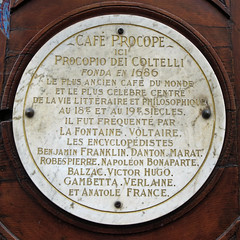Dr Jean-Paul Marat


Dr Jean-Paul Marat
(1743-1793)
Commemorated on 1 plaque
Café Procope. Ici Procopio dei Coltelli fonda en 1686 le plus ancien café du monde et le plus célèbre centre de la vie littéraire et philosophique au 18e et au 19e siècles. Il fut fréquenté par La Fontaine, Voltaire, les Encyclopédistes, Benjamin Franklin, Danton, Marat, Robespierre, Napoléon Bonaparte, Balzac, Victor Hugo, Gambetta, Verlaine et Anatole France.
English translation: Café Procope. Here Procopio dei Coltelli founded in 1686 the oldest café in the world and the most famous center of philosophical and literary life in the 18th and 19th centuries. It was visited by La Fontaine, Voltaire, Les Encyclopédistes, Benjamin Franklin, Danton, Marat, Robespierre, Napoléon Bonaparte, Balzac, Victor Hugo, Gambetta, Verlaine and Anatole France.
13 rue de l'Ancienne Comédie, Paris, France where they visited

